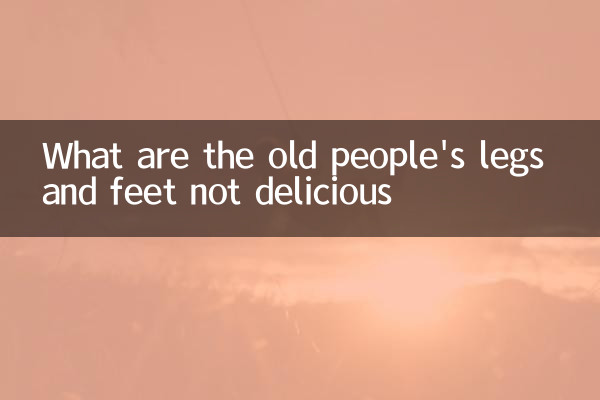Why do old people's legs and feet feel bad? Top 10 Nutritious Food Recommendations and Dietary Guidelines
With the development of an aging society, the problem of inconvenience in the legs and feet of the elderly has become increasingly common. A reasonable diet can not only supplement nutrition, but also improve bone health and relieve joint pain. The following are the dietary recommendations for the health of the legs and feet of the elderly that have been hot topics on the Internet in the past 10 days. They are analyzed in detail based on structured data.
1. Why do elderly people with poor legs and feet need special diet?

Inconvenience in the legs and feet of the elderly is often related to problems such as osteoporosis, arthritis, and muscle atrophy. Supplementing nutrients such as calcium, vitamin D, and protein through diet can enhance bone strength, reduce inflammatory reactions, and improve muscle strength.
| FAQ | Nutrients needed | Mechanism of action |
|---|---|---|
| osteoporosis | Calcium, Vitamin D, Magnesium | Promote bone density growth |
| joint pain | Omega-3, collagen | Reduce joint inflammation |
| muscle weakness | High-quality protein, vitamin B12 | Maintain muscle mass |
2. 10 recommended ingredients and scientific basis
According to recent nutritional research and clinical data, the following foods have a significant effect on improving leg and foot problems in the elderly:
| Ingredient name | key nutrients | Recommended daily intake | cooking suggestions |
|---|---|---|---|
| salmon | Omega-3 fatty acids | 100-150g | Steam or bake at low temperature |
| black sesame seeds | Calcium, Vitamin E | 20-30g | Grind powder and add to porridge |
| egg | High-quality protein, vitamin D | 1-2 pieces | Boiled or steamed egg custard |
| dark green vegetables | Vitamin K, folic acid | More than 300 grams | Stir-fry quickly to retain nutrients |
| Soy products | Plant protein, isoflavones | 50-100g | Avoid deep-frying |
3. Three golden principles of diet matching
1.High calcium and low phosphorus ratio: The optimal calcium to phosphorus ratio is maintained at 2:1 to avoid excessive red meat affecting calcium absorption.
2.anti-inflammatory diet: Increase the proportion of fruits and vegetables to 50% and reduce refined carbohydrates
3.Eat less, eat more often: 5-6 meals a day to reduce digestive burden and ensure continuous supply of nutrients
4. Three types of foods that need to be eaten with caution
| food type | Potential risks | alternative |
|---|---|---|
| High salt pickled products | Accelerate calcium loss | Use spices for seasoning |
| sugary drinks | Cause chronic inflammation | Switch to light soy milk |
| alcoholic beverages | Disrupt vitamin absorption | grape juice substitute |
5. 7-day recipe demonstration (can be adjusted according to the season)
Monday breakfast:
• Oatmeal milk porridge (50g oats + 200ml milk)
• 1 boiled egg
• Cold spinach 100g
Wednesday lunch:
• Multigrain rice (brown rice + millet) 80g
• Steamed seabass 150g
• 200g baby cabbage for soup
• 1 bowl of seaweed and tofu soup
6. Special reminder
1. Patients with high blood pressure or diabetes need to adjust their diet as directed by their doctor.
2. Exercise appropriately 30 minutes after meals to promote nutrient absorption
3. Regularly test serum vitamin D and bone density indicators
4. People with difficulty swallowing can choose to break the food wall
Through scientific diet combined with moderate exercise, the function of the legs and feet of the elderly can be effectively improved. It is recommended to keep a food diary every week and evaluate the physical improvement after 3 months. If you have persistent pain or difficulty moving, you should seek medical examination promptly.

check the details

check the details